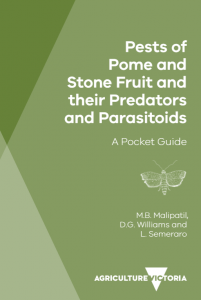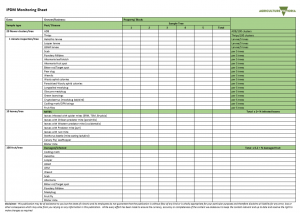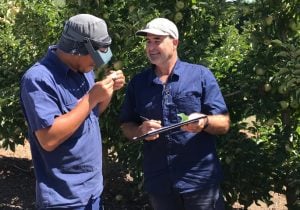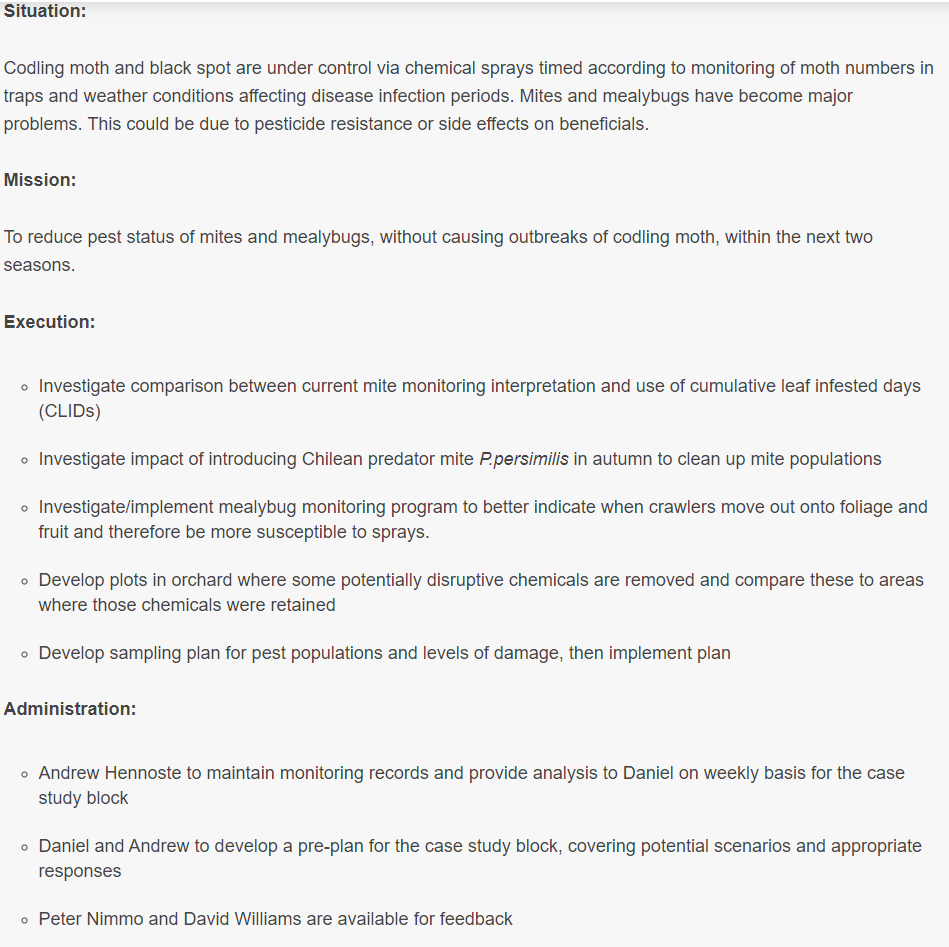Australian Pome fruit orchardists vary in their tolerance of fruit damage and appearance of the fruit. The most important measure of success is the marketable yield per hectare. This is defined as the number of cartons or number of kilograms of fruit that meet or exceed the market standards for appearance, taste, firmness, and sugar. Marketable yield therefore depends on the crop load and the ability of the grower to protect the fruit from damage by wind, sunburn, limb-rub, pests and diseases, storage disorders, and rough handling during and after harvest. It is possible to produce ‘perfect’ fruit without any blemish but often the costs of achieving that can exceed the returns. Growers practicing IPM accept that some levels of pest and disease can be tolerated without incurring economic losses.
IPM involves making personal choices about what you think is acceptable and then developing strategies to reduce the perceived risks associated with those choices. A well run IPM program involves no reduction in marketable yield because pest and disease management is integrated into the production system rather than being treated as a stand-alone component. This takes practice and experimentation that allows the grower to develop confidence in the new techniques. As with all changes in techniques, use of new tools, or learning to drive mistakes can happen but careful planning and mentoring reduces the risks of serious accidents occurring. A pest management plan should be developed before the beginning of each season and should identify potential unintended mistakes that may occur and the actions necessary to correct them. A good practical cost-effective monitoring system is an important tool to identify issues before they become problems.
Some guidelines to avoid mistakes and minimise risk during your transition to IPM are listed below:
Start small
There is no need to take excessive risks. IPM usually involves either a reduction in the number, or type, of pesticide sprays in order to encourage establishment of biological control agents. This could mean that some pests that were being controlled by broad-spectrum pesticides may initially increase their populations until the naturally occurring biological control agents (that were previously being killed by the pesticides) detect the pests and start to exert control. Never convert an entire orchard or a large, high-value block during the first few seasons of transition. Always introduce IPM gradually. You can use a low-value block of medium to large size to develop your skills and confidence. As you gain confidence, extend IPM across the whole orchard.
Take it step by step
Identify your major pest or disease challenge and consider whether it is a secondary problem resulting from how you are treating another pest or disease. If you think that your major problem is a result of chemicals used to control another pest then change one aspect of your strategy to manage the second pest and evaluate the impact of that change on both pests until you are happy with the result. Gradually introduce changes to other management practices.
Know your pests
To start with focus only on those pests that have been in your orchard over the last four seasons and were responsible for some financial loss. Find out all you can about the pests and diseases that attack your orchard:
- When can you expect them to occur?
- What do they look like (particularly early, before they have had a chance to do serious damage)?
- What are the symptoms of damage that allow you to identify the cause without seeing the pest?
- When is the most effective time to control them?
You should also become familiar with the beneficial organisms that are likely to become more common in your orchard as you convert more and more blocks to IPM.
A guide for diagnosis and identification of the pests and predators of pome and stone fruit can be downloaded free from here: Pests of Pome and Stone Fruit and their Predators and Parasitoids

Keep detailed records
Keep detailed records of monitoring, management, weather and rejected fruit. All these records are required for planning and implementation of IPM program. Monitoring methods and timing, and record sheets can be downloaded free from here:

Storing the results in a spreadsheet can allow you to graph the pest and predator populations and allow you to compare timing and size of the populations across seasons and varieties.
Management records
When making decisions on pest management it is important to have a complete set of financial records from previous seasons. Balance the financial inputs associated with pest management against the economic benefits.
Weather records
Many pests respond to the weather in a predictable way. Rainfall, temperature and humidity records are particularly useful. Over a series of seasons an accurate picture of what pests are likely to become problems following a certain type of weather will become clear. Automated weather stations that record, store and analyse data to predict events are readily available and useful tools.
Rejected-fruit records
Infections that occur in the orchard may not show up until fruit is harvested. Keep a record of the quantities of fruit rejected or downgraded in the shed, in storage or on the grading/packing line, together with the reasons for rejection.
Monitoring is very important
Monitor your trees and the weather: The type of monitoring done will be determined by the types of pests that are likely to cause problems. For some pests, careful observation and detection can allow early, effective action to be taken. Systematic visual monitoring of the orchard block can save money and time later in the season. In other cases, even detection of the very earliest stages of the pest are too late to prevent significant damage. However, monitoring the weather that allows the pest to develop may give forewarning of its arrival.
In IPM a ‘block’ is an area that is managed as a unit. This includes pest and disease management (e.g. spraying).
Choose trees randomly each time you perform monitoring and use a pattern that allows you to visit all parts of the block. Be aware of pest ‘hotspots’ from past seasons but do not focus on them entirely and neglect to look at other parts of the block. If you focus just on previous hotspots you run the risk of over-reacting by spraying the entire block or, possibly worse, not detecting a new outbreak elsewhere in the block. This is also the reason why monitoring fixed sentinel trees is not a good idea.
Even though the trees between the monitored trees are not formally part of the sample used for monitoring it is important to look out for unusual pest activity as you walk through each time.
Monitoring methods, sample size, timing and record sheets are available for download here: https://extensionaus.com.au/ozapplepearipdm/test-post_monitoring-sheet/
Know how much time it takes to monitor: Allow sufficient time to do monitoring. It should never be deferred because of other commitments. When IPM fails it is almost always because monitoring loses priority at peak times. if you don’t have enough time to do it properly, hire a consultant or scout. For a beginner, as a rough guide, the time needed will be: 15 to 20 minutes per hectare every 7 to 14 days at peak times. With passage of time you will gain confidence and this time will be reduced.

Terry Martella, Kirup WA, monitoring and recording in his orchard with staff.
Take action only when you need to
Know your thresholds: An action threshold is reached when monitoring indicates that the financial loss caused by a pest will be unacceptable unless remedial action is taken. At this point something must be done to control the pest. If a pest is not costing you money or causing other problems, why waste time, money and effort controlling it? In some cases threshold damage levels have been published. Thresholds are important tools for avoiding either pest damage or unnecessary sprays, but in most cases orchardists will need to decide upon reasonable thresholds themselves. The key to deciding on a reasonable action threshold is to keep good records of problem pests in last 2-5 years, damaged caused by them, which control measures worked and which did not, and cost involved.
Check your spray coverage: There are many reasons why a pesticide application can fail to control a pest. Although it’s tempting to look for complex reasons, often the solution is simply that the rig was not set up to provide good coverage. This is particularly the case when the trees are dense or tall, or when pests tend to shelter in rough bark or other cryptic parts of the tree. Your spray rig should be properly calibrated before each season. It is also good practice to check coverage immediately after a pesticide is suspected of failing, so as to eliminate this possibility. Quick evaluation of Spray coverage can be done by use of Spray cards or visually assessing spray coverage by using ultra violet (UV) fluorescent dyes.
Evaluate the season
Record which pests caused trouble, quantify the damage and determine which types of management worked.
Plan for the next season
Start with a situation statement that summarises the background to the block, the main issues being addressed and how, what worked, what didn’t work, and why you think you got the results that you did. Your evaluation of the previous season is a good reference for developing the situation statement. Then create a mission statement that puts focus on your main objectives without being too specific about individual pests or diseases. An example of an IPM mission statement is “To achieve acceptable control of pests and diseases without negative effects on beneficials and financial performance”. Once you are clear on your situation and mission you can focus on execution of strategies to achieve your mission. The strategies should be brief dot points rather than prescriptive instructions (tasks) because you need flexibility to adapt as circumstances change during the season. An example of a strategy is “Investigate use of cumulative leaf infested days (CLIDs) instead of mites/leaf to determine the need to spray”. Once you have your strategies identified you need to identify what actions are required to implement those strategies and who is responsible for undertaking those actions. You can list these under the heading “Administration” or “Actions”.
There is no point in doing any of the above if there is no structure to allow communication among those responsible for the actions and achievements, and any consultants etc who could be used for strategic advice. A simple table with name, phone and email details of relevant people is sufficient.
Finally, recognise that there is always some risk attached to any strategy, and identify sources of stress and ways to reduce their impact (such as having a predetermined response to possible alternative outcomes and problems. These can be listed as dot points under the heading “Safety”
The result of this planning exercise is what emergency management agencies call a SMEACS briefing that ideally is no more than one or two pages and acts as a memory prompt and a way of delivering a consistent briefing to multiple staff on what, how and when you are hoping to achieve in your IPM program.
An example of an IPDM Action Plan is shown below (based on the headings used in SMEACS briefings) and more can be seen on this webpage listed under case studies for each state here: https://extensionaus.com.au/ozapplepearipdm/case-study-orchards/

